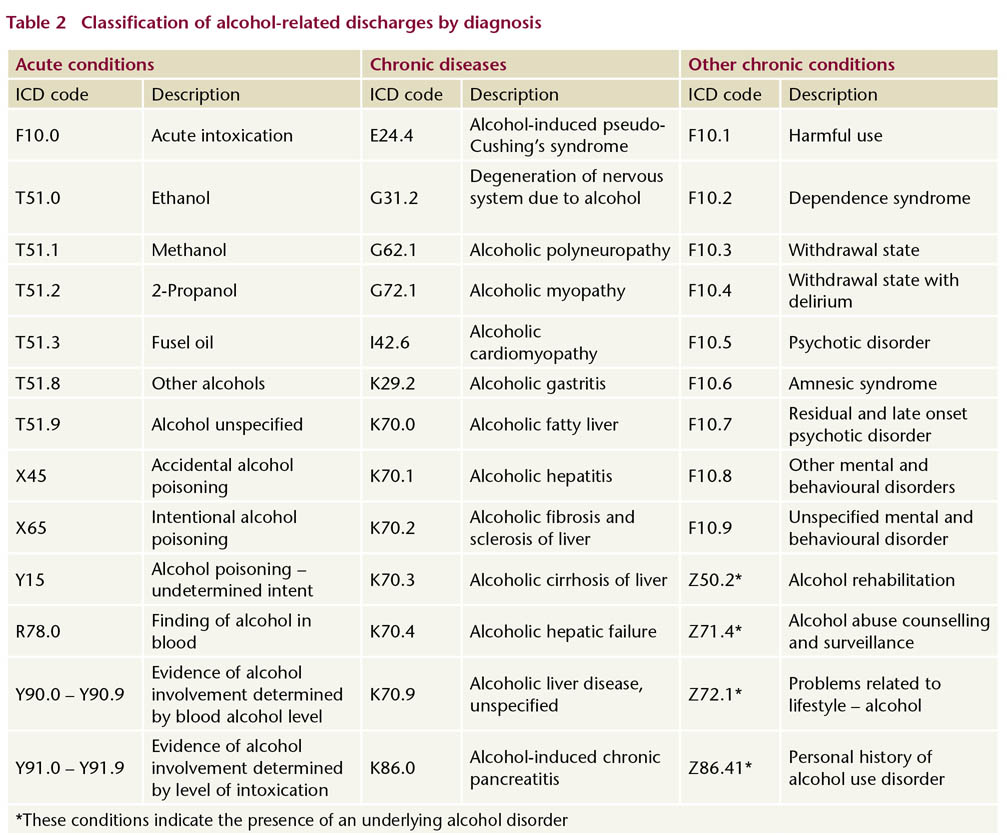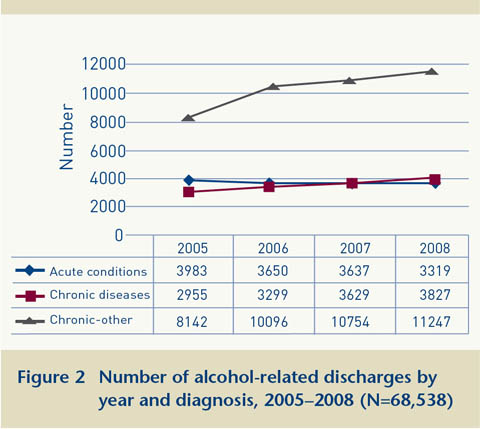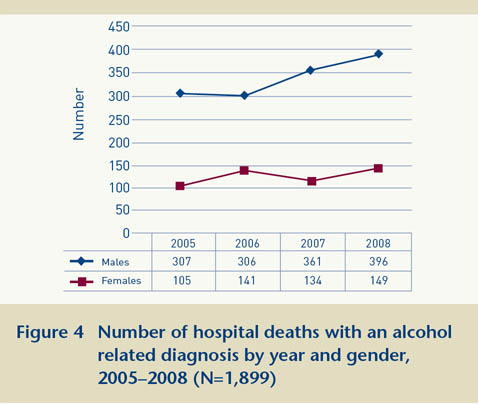Mongan, Deirdre
(2010)
The burden of alcohol-related morbidity on hospital services.
Drugnet Ireland,
Issue 35, Autumn 2010,
pp. 9-12.
The Economic and Social Research Institute (ESRI) manages the Hospital In-Patient Enquiry (HIPE) scheme. This is a computerised health information system designed to collect clinical and administrative data on discharges from over 60 acute hospitals in Ireland.
This article reports on an analysis of HIPE data on discharges, including deaths in hospital, of cases with an alcohol-related diagnosis in the years 2005–2008, in order to assess the burden of alcohol-related morbidity on Irish hospitals. It is important to note that, because the HIPE scheme does not record attendances at emergency departments, using HIPE data to assess the impact of alcohol use on acute hospital services can lead to an under-estimation of the true extent of the burden.
Number of alcohol-related discharges
Between 2005 and 2008 the number of alcohol-related discharges increased by 22% (Table 1). Changes in the classification of alcohol-related diagnoses introduced in the tenth version of the International Classification of Diseases – ICD-10, may explain the low number of discharges in 2005. Males accounted for 74% and females for 26% of all discharges. In 2008 the average length of stay was nine days and alcohol-related discharges accounted for 3.6% (161,016) of all bed days. According to the Health Service Executive (HSE), the average cost per bed day in 2008 was €889.1 We can therefore deduce that alcohol-related discharges cost €143,143,224 in 2008.
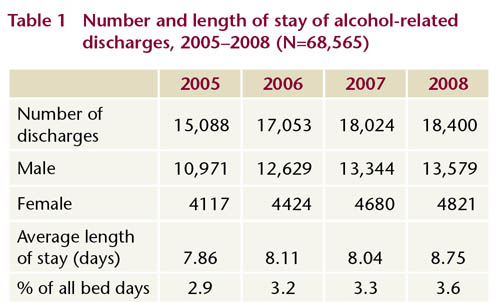
Discharges by age
The mean age of discharges was 48 years, and the median was 49 years. There was little difference in the age profile of males and females, although male discharges tended to be older, with 51% aged 50 years or over, compared to 43% of women (Figure 1). One explanation for this may be that health complications arising from alcohol tend to manifest themselves earlier in the drinking careers of women than in men. Alternatively, these trends may be attributable to the fact that middle-aged and older women in Ireland drink less than men and are also more likely to abstain from alcohol altogether.2 Those aged under 18 accounted for 3% (2,083) of all discharges. Males accounted for 55% and females for 45% of discharges aged under 18.
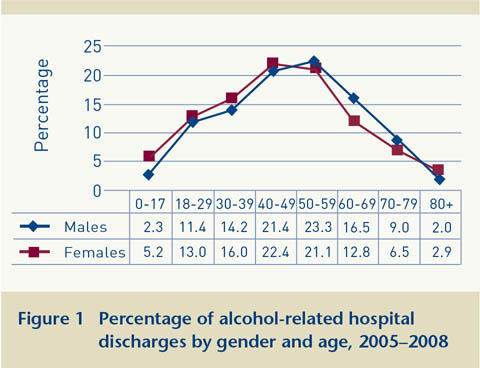
Discharges by diagnosis
Alcohol-related discharges were categorised according to diagnosis into one of the following groups: acute conditions, chronic diseases and other chronic conditions (Table 2). Twenty-seven discharges with a diagnosis relating to fetal alcohol syndrome are not presented in this analysis.
For the purposes of this analysis, cases with both an acute and a chronic diagnosis were recorded in the chronic category, and cases with both a chronic disease and a chronic condition were recorded in the chronic disease category. Acute conditions accounted for 18%, chronic diseases for 21% and other chronic conditions for 61% of alcohol-related discharges in 2008 (Figure 2).
Alcoholic liver disease accounted for three-quarters of all alcohol-related chronic diseases (Table 3). Alcoholic gastritis and alcohol-induced chronic pancreatitis each accounted for 9% of chronic diseases. Between 2005 and 2008, 71 discharges had a liver transplant during their hospital stay.
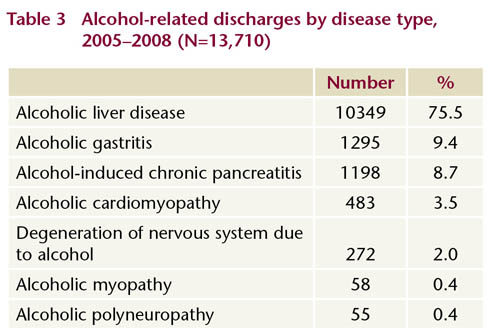
Acute conditions were more prevalent among younger people, while chronic diseases and other chronic conditions were more common among older age groups (Figure 3). The numbers admitted with chronic diseases or other chronic conditions increased steadily with age and peaked in the 50–59-year age group; the number decreased steadily among those aged 60 years or over. Acute conditions accounted for 59% of discharges aged under 30. However, it is somewhat worrying that in the four years 2005–2008 there were 4,129 discharges aged under 30 with chronic conditions or diseases, given that these conditions usually develop after a number of years of harmful drinking and are normally seen in much older people.
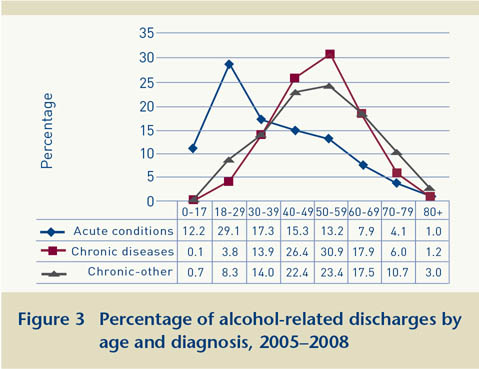
Deaths in hospital of cases with an alcohol-related diagnosis
In the period 2005–2008, 1,899 (2.8%) cases died while still in hospital; 1,001 (53%) had an alcohol-related disease, 813 (43%) had a chronic condition and 85 (4%) had an acute condition. Males accounted for 72% of deaths (Figure 4).
Over half (52%) of deaths occurred among those aged 50–70 years. Male deaths peaked in the 60–69-year age group and female deaths peaked in the 50–59-year age group (Figure 5).
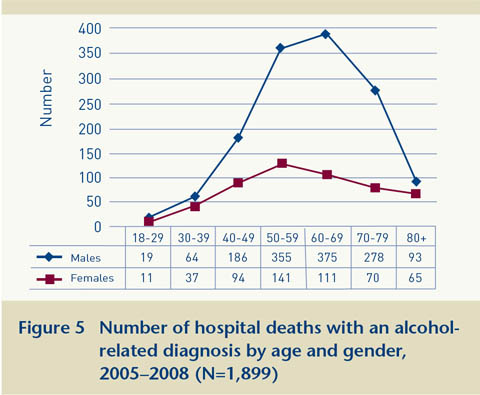
Those aged under 65 accounted for 61% (1,156) of deaths, highlighting the link between alcohol-related conditions and premature mortality. As these people were of working age, these deaths represent a considerable economic loss to the country and contribute to the wider, intangible human costs associated with premature mortality due to alcohol.
Discharges with additional mental health, drug or trauma diagnoses
There is a close relationship between alcohol problems and mental health. People with mental health problems are at increased risk of alcohol problems, and vice versa. One in ten male and one in five female cases discharged in the four-year period had a mental health diagnosis in addition to an alcohol-related diagnosis (Table 4). Eleven per cent of discharges had an additional drug-related diagnosis, and half of these were aged 15–34 years. Female discharges (18%) were twice as likely as males (9%) to have a drug-related diagnosis. A large number of the female cases were related to intentional poisoning by analgesics or psychotropic agents in conjunction with alcohol.
Acute consequences of alcohol use such as road traffic accidents and assaults were experienced primarily by males, and three-fifths occurred among those aged 15–34 years. One in ten discharges had experienced a fall, with one in five falls occurring among those aged 65 or over. Alcohol problems among the elderly can be hard to detect and often go undiagnosed. The clinical presentation of harmful use of alcohol in elderly people may differ from that in younger people, with elderly people more likely to present with non-specific complaints, including falls, which may mask the underlying problem alcohol use.

Conclusion
These results indicate that alcohol-related morbidity is a considerable burden on Irish hospitals, with alcohol-related discharges accounting for 161,016 of all bed days in 2008 at a cost of €143,143,224. The data presented here do not include emergency department presentations; we can therefore conclude that the actual burden of alcohol to acute Irish hospitals is substantially higher.
1. HSE National Casemix Programme (2010) Letter dated 17 February in response to Parliamentary Question [5857/10] put to the Minister for Health and Children by Caoimhghín Ó Caoláin TD. Dáil Éireann, 4 February 2010. Accessed 17 August 2010 at
www.hse.ie/eng/about/PersonalPQ2. Morgan K, McGee H, Dicker P, Brugha R, Ward M, Shelley E et al. (2009) SLÁN 2007: survey of lifestyle, attitudes and nutrition in Ireland. Alcohol use in Ireland: a profile of drinking patterns and alcohol-related harm from SLÁN 2007. Dublin: Department of Health and Children.


